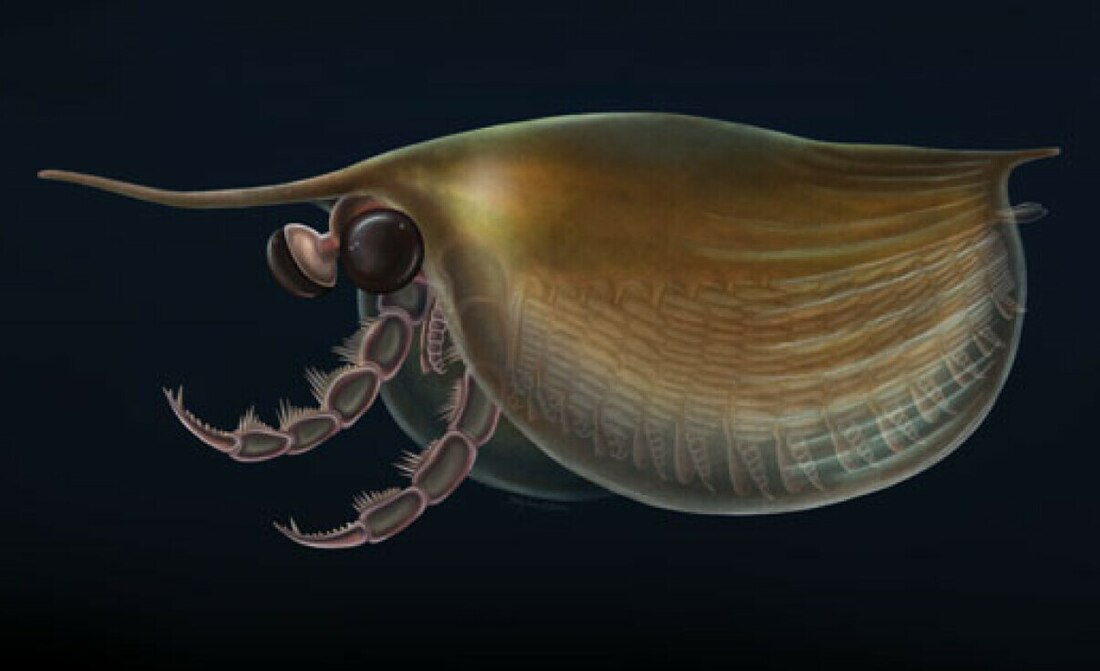Top Qs
Timeline
Chat
Perspective
Isoxyida
Extinct order of arthropods From Wikipedia, the free encyclopedia
Remove ads
Isoxyids are members of the order Isoxyida and the family Isoxyidae, a group of basal arthropods that existed during the Cambrian period. Its best known members are Isoxys, with 20 species found worldwide, and Surusicaris, known from a single species found in the Burgess Shale of Canada. Isoxyida is also sometimes taken to include the family Sunellidae, which comprises four genera: Sunella, Combinivalvula, Jinningella and Caudicaella, all of which are known from deposits in China,[1] with Caudicaella also known from the Heatherdale Shale of South Australia.[2] Isoxys and Surusicaris are distinguished by their bivalved carapaces and pair of upward curving grasping frontal appendages. Sunellids also had bivalved carapaces, but unlike other isoxyids these were distinguished by the presence of an anterodorsal sulcus on their carapaces. These arthropods are thought to have been predators, hunting soft-bodied prey in either the water column, or close to the seabed.[3][4][5]
Remove ads
Description
Isoxys and Surusicaris have a combination of features seen in both stem-group arthropods, as well as more advanced taxa. They have semicircular bivalved carapaces, large, spherical eyes, a pair of large upward curling frontal appenages covered in spines, and pairs of biramous limbs running along the body. The trunk region appears to be unsegmented and lacks sclerotisation, similar to radiodonts, with a segmented and sclerotised (arthropodized) trunk being characteristic of most arthropods.[6][3] On the other hand, sunellids are known mostly from carapaces and their fossils do not preserve frontal appendages similar to those of Isoxys, but some preserve soft tissue, including an apparently segmented trunk, trunk appendages, large, spherical eyes and a possible median eye.[7] Their bivalved carapaces also have an anterodorsal sulcus, a character shared with bradoriids, another group of similar but unrelated arthropods.[1]
Remove ads
Distribution
Isoxys has an almost cosmopolitan distribution, and is known from twenty species distributed in deposits of North America, Siberia, Australia, China and Europe. Surusicaris is limited to the Burgess shale site in British Columbia, and only contains a single species.[5] The four genera of Sunellidae are known from the Chengjiang biota and the Qingjiang biota in China, while Caudicaella is also known from the Heatherdale Shale in South Australia.[2]
Remove ads
Taxonomy
Summarize
Perspective
| |||||||||||||||||||
This cladogram shows the relationships of the isoxyids compared to other arthropod groups, according to the results of Zhang et al. 2023.[6]
The true classification of the isoxyids has been somewhat controversial. Although they are often regarded as basal arthropods, where they actually fit into the arthropod family tree has been contested. Originally, it was thought that Isoxys was related to another bivalved arthropod from the Cambrian, Tuzoia, due to the similar aspects of their carapaces. However, a study in 2022 found that Tuzoia was a member of Hymenocarina, and that it was not closely related to the isoxyids. Currently the group has been placed into the Deuteropoda, a proposed clade of arthropods whose members are distinguished by an anatomical reorganization of the head region, including the appearance of a differentiated first appendage pair (the 'deutocerebral' pair), a multisegmented head, and a hypostome/labrum complex,[8][9][10] being placed outside the crown group of Arthropoda, with both Mandibulata and Chelicerata being more closely related to each other than to isoxyids.[6]
Ecology
Species of the Isoxyida are thought to have been actively swimming predators, using their frontal appendages to capture soft-bodied prey, with the frontalmost pairs of biramous limbs aiding in food processing.[6] The various species of the order are thought to have occupied a variety of niches, from swimming just above the seafloor (nektobenthic) to open ocean swimmers (pelagic).[5] Swimming was likely accomplished by rhythmic movement of the legs.[6] Isoxyid species with elongated carapace spines are likely to have engaged in vertical migration up and down the water column, like many modern marine invertebrates.[5]
Remove ads
Gallery
- Diagram of Surusicaris
- Diagram of Isoxys curvirostratus
- The holotype, and only known fossil, of Surusicaris
- Fossil of Isoxys acutangulus
See also
References
Wikiwand - on
Seamless Wikipedia browsing. On steroids.
Remove ads






